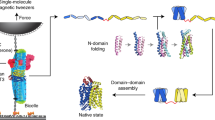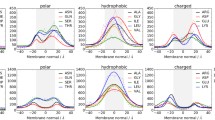Abstract
Given the sequence of transporters or channels of unknown secondary structure, it is usual to predict their putative transmembrane regions as α-helical. However, recent evidence for a facilitative glucose transporter (GLUT1_ appears inconsistent with such predictions, which has led us to propose an alternative folding model for GLUTs based on the 16-stranded antiparallel β-barrel of porins. Here we apply the same predictive algorithms we used for GLUTs to several other membrane proteins. For some of them, a high-resolution structure has been derived (β-barrels: Rhodobacter capsulatus andEscherichia coli porins; multihelical: colicin A, bacteriorhodopsin, and reaction center L chain); we use them to test the prediction procedures. The other proteins we analyze (GLUT1, CHIP28, acetylcholine receptor alpha subunit, lac permease, Na+-glucose cotransporter, shaker K+ channel, sarcoplasmic reticulum Ca2+-ATPase) are representative of classes of similar membrane proteins. As with GLUTs, we find that the predicted transmembrane segments of these proteins are consistently shorter than expected for transmembrane spanning α-helices, but are of the correct length and number for the proteins to fold instead as porin-like β-barrels.
Similar content being viewed by others
References
Henderson R, Baldwin JM, Ceska TA, Zemlin F, Beckmann E, Downing KH: Model for the structure of bacteriorhodopsin based on highresolution electron cryo-microscopy. J Mol Biol 213: 899–929, 1990
Deisenhofer J, Epp O, Miki K, Huber R, Michel H: Structure of the proteins subunits in the photosynthetic reaction center of Rhodopseudomonas viridis at 3 Å resolution. Nature 318: 618–624, 1985
Parker MW, Postma JPM, Pattus F, Tucker AD, Tsernoglu D: Refined structure of the pore-forming domain of colicin A at 2.4 Å resolution. J Mol Biol 224: 639–657, 1992
Weiss MS, Kreusch A, Schiltz E, Nestel U, Welte W, Weckesser J, Schulz GE: The structure of porin from Rhodobacter capsulatus at 1.8 Å resolution. FEBS Lett 280: 379–382, 1991
Cowan SW, Shirmer T, Rummel G, Steiert M, Ghosh R, Pauptit RA, Jansonius JN, Rosenbusch JP: Crystal structures explain functional properties of twoE. coli porins. Nature 358: 727–733, 1992
Nikaido H, Saier MH: Transport Proteins in Bacteria: Common Themes in Their Design. Science 258: 936–942, 1992
Kaback HR: In and out and up and down with lac permease. Int Rev Cytol 137A: 97–125, 1992
Calamia J, Manoil C: Lac permease ofEscherichia coli: Topology and sequence elements promoting membrane insertion. Proc Natl Acad Sci USA 87: 4937–4941, 1990
Foster DL, Boublik M, Kaback HR: Structure of the lac carrier protein ofEscherichia coli. J Biol Chem 258: 31–34, 1983
Vogel H, Wright JK, Jahnig F: The structure of the lactose permease derived from Raman spectroscopy and prediction methods. EMBO Journal 4: 3625–3631, 1985
Radding W: Proposed partial beta-structures for lac permease and the Na+/H+ antiporter which use similar transport and H+ coupling mechanism. J Theor Biol 150: 239–249, 1991
Mueckler MM, Caruso C, Baldwin SA, Panico M, Blench I, Morris HR Allard WJ, Lienhard GE, Lodish HF: Sequence and structure of a human glucose transporter. Science 229: 941–945, 1985
Chin JJ, Jung EKY, Chen V, Jung CY: Structural basis of human erythrocyte glucose transporter function in proteoliposome vesicles: Circular dichroism measurements. Proc Natl Acad Sci USA 84: 4113–4116, 1987
Chin JJ, Jung EKY, Jung CY: Structural basis of human erythrocyte glucose transporter function in reconstituted vesicles, α-helix orientation. J Biol Chem 261: 7101–7104, 1986
Park K, Perezel A, Fasman GD: Differentiation between transmembrane helices and peripheral helices by the deconvolution of circular dichroism spectra of membrane proteins. Protein Science 1: 1032–1049, 1992
Alvarez J, Lee DC, Baldwin SA, Chapman D: Fourier transform infrared spectroscopic study of the structure and conformational changes of the human erythrocyte glucose transporter. J Biol Chem 262: 3502–3509, 1987
Fischbarg J, Cheung M, Czegledy F, Li J, Iserovich P, Kuang K, Hubbard J, Garner M, Rosen OM, Golde DW, Vera JC: Evidence that facilitative glucose transporters may fold as β-α-barrels. Proc Natl Acad Sci USA 90: 11658–11662, 1993
Rost B, Sander C: Jury returns on structure prediction. Nature 360: 540, 1992
Kyte J, Doolittle RF: A simple method for displaying the hydropathic character of a protein. J Mol Biol 157: 105–132, 1982
Eisenberg D, Weiss RM, Terwilliger TC: The hydrophobic moment detects periodicity in protein hydrophobicity. Proc Natl Acad Sci USA 81: 140–144, 1984
Prevelige P, Fasman GD: Chou-Fasman prediction of the secondary structure of proteins: Chou-Fasman-Prevelige algorithm. In: G.D. Fasman (ed). Prediction of protein structure and the principles of protein conformation. Plenum Press, New York, London, 1989, pp 391–416
Crofts AR: Protein Sequence Analysis and Modeling for Windows 3 [], University of Illinois, Urbana, IL. (Ph.D.; Dissertation). Anonymous FTP at memo.life.vinc.edu, pub/pdrwim and pub/psaam subdirectories, 1992
Karlin A: Explorations of the nicotinic acetylcholine receptor. The Harvey Lectures series 85: 71–107, 1991
Akabas MH, Stauffer DA, Xu M, Karlin A: Acetylcholine receptor channel structure probed in cysteine-substitution mutants. Science 258(5080): 307–310, 1992
MacKinnon R: Determination of the subunit stoichiometry of a voltage-activated potassium channel. Nature 350: 232–235, 1991
Gribskov M, Luthy R, Eisenberg D: Profile analysis. In: R.F. Doolittle (ed). Methods in Enzymology. Academic Press, New York, 1990, pp 146–159
Bowie JU, Luthy R, Eisenberg D: A method to identify protein sequences that fold into a known three-dimensional structure. Science 253: 164–170, 1991
Paul C, Rosenbusch JP: Folding patterns of porin and bacteriorhodopsin. EMBO Journal 4: 1593–1597, 1985
Farber GK, Petsko GA: The evolution of alpha/beta barrel enzymes. TIBS 15: 228–234, 1990
Bogusz S, Boxer A, Busath DD: An SS1-SS2 beta-barrel struchire for the voltage-activated potassium channel. Protein-Eng 5(4): 285–293, 1992
Fischbarg J, Kuang K, Li J, Arant-Hickman S, Vera JC, Silverstein SC, Loike JD: Facilitative and sodium dependent glucose transporters behave as water channels. In: H.H. Ussing, J. Fischbarg, E. Sten Knudsen, E. Hviid Larsen and N.J. Willumsen (eds). Proc. Alfred Benzon Symposium 34, ‘Water transport in leaky epithelia’. Munksgaard, Copenhagen, 1993, pp 432–446
Asano T, Katagiri H, Tsukuda K, Lin JL, Ishihara H, Yazaki Y, Oka Y: Glucose binding enhances the papain susceptibility of the intracellular loop of the GLUT1 glucose transporter. FEBS Lett 298: 129–132, 1992
Preston GM, Carroll WB, Guggino WB, Agre P: Appearance of water channels in Xenopus oocytes expressing red cell CHIP28 protein. Science 256: 385–387, 1992
Maurel C, Reizer J, Schroeder JI, Chrispeel MJ: the vacuolar membrane protein r-TIP creates water specific channels in xenopus oocytes. EMBO Journal 12: 2241–2247, 1993
Fischbarg J, Kuang K, Vera JC, Arant S, Silverstein SC, Loike J, Rosen OM: Glucose transporters serve as water channels. Proc Natl Acad Sci USA 87: 3244–3247, 1990
Hasegawa H, Skach W, Baker O, Calayag MC, Lingappa V, Verkhman AS: A multifunctional aqueous channel formed by CFTR. Science 258: 1477–1479, 1992
Author information
Authors and Affiliations
Rights and permissions
About this article
Cite this article
Fischbarg, J., Cheung, M., Li, J. et al. Are most transporters and channels beta barrels?. Mol Cell Biochem 140, 147–162 (1994). https://doi.org/10.1007/BF00926753
Issue Date:
DOI: https://doi.org/10.1007/BF00926753




